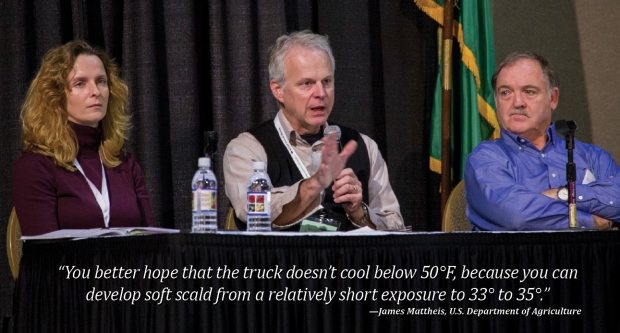
From left, Dr. Ines Hanrahan, Jim Mattheis and Dr. Chris Watkins speaks about quality issues during the Honeycrisp session at the Washington State Horticultural Association’s annual meeting in Kennewick, Washington on December 3, 2014. (TJ Mullinax/Good Fruit Grower)
The apple industry is still trying to learn how to best manage harvest and storage of Honeycrisp apples, a variety that behaves differently than all others. A panel of scientists recently summarized the latest research relating to management strategies of Honeycrisp.
Representing Honeycrisp research from both sides of the United States, Drs. Chris Watkins of Cornell University, James Mattheis, U.S. Department of Agriculture, Wenatchee, Washington, and Washington Tree Fruit Research Commission’s Ines Hanrahan, answered the following questions:
Is Brix level a good maturity index?
Mattheis says you can get yourself into trouble using Brix to predict long-term storage potential. “If you have the value too high and are waiting before harvest to reach it, fruit can become too mature,” he said. “A better way to use Brix is in helping identify fruit that should be marketed right away.”
Hanrahan said that in low-Brix years, growers might not reach the target. Watkins said, “Unlike other varieties, there’s no hard and fast maturity index for Honeycrisp. It tells you when it’s ready when you see color on the tree.”
He suggests looking at the brightness of color against the background color. “And there is no substitution for tasting fruit and having multiple picks as much as it is feasible.”
How do you explain what color to pick?
Hanrahan tells her crew to think of the apple in quarter sections. She gives examples of fruit with the right color to workers to put in their pocket. “You have to recalibrate your eyes every so often, because you slip over time,” she said, adding the checker has to ensure the color target is being met. “Everybody should have a piece of fruit they can compare to throughout the day.”
Why is conditioning important?
Honeycrisp grown under Washington conditions are sensitive to chilling injuries and need conditioning before being placed in cold storage. Without conditioning, fruit are at risk of developing soft scald or soggy breakdown. Research has shown that keeping fruit at 50°F for a week and then placing it in rooms at 36° to 38°F will reduce soft scald.
Watkins said a good prediction model is needed that can identify lots predisposed to soft scald. He noted that operators in western New York got by for several years without conditioning fruit before storage, but have had problems in recent years.
Mattheis warned against shortening the conditioning time to less than a week. Research showed an increase in soft scald in fruit held less than seven days. Also, 50°F appears to be the magic conditioning temperature. Temperatures above 50° have been shown to exacerbate greasiness, increase bitter pit, and decrease acidity levels.
Packers that run fruit immediately after harvest, without conditioning for seven days, run the risk of soft scald and other chilling injuries occurring from cold temperatures during transit.
“You better hope that the truck doesn’t cool below 50°F, because you can develop soft scald from a relatively short exposure to 33° to 35°,” he said, adding that destination storage temperatures are also likely to be well below 50°.
“If you precondition a highly sensitive lot, you can greatly reduce soft scald,” said Hanrahan. “You can’t completely eliminate it, but it will be better than if you’d done nothing.”
How can fruit drop be prevented?
Fruit drop of Honeycrisp in New York tends to be regional, said Watkins. In his work, he’s found that Honeycrisp responds well to ReTain (aminoethoxyvinylglycine) and Harvista, the preharvest formulation of MCP (1-methylcyclopropene) in preventing fruit drop at harvest.
When should MCP be applied?
Mattheis has looked at different timings of SmartFresh (MCP) in storage, from immediately after harvest and later. In general, he’s found that the sooner SmartFresh is applied, the better the control of greasiness. He’s not seen negative effects from applying right after harvest. SmartFresh and controlled atmosphere can slow acid loss and development of greasiness. Carbon dioxide levels of 0 .5 to 1.0 percent should be used because Honeycrisp is not as prone to carbon dioxide injury as other apple varieties.
Which wax works best?
Mattheis hasn’t done research on waxes on Honeycrisp, but noted that shellac is a much more restrictive than carnauba for gas exchange. Soggy breakdown results from chilling injury, not carbon dioxide injuries. For fruit picked, packed, and shipped right away, carnauba seems to work fine, he said, although once fruit becomes a little greasy, carnauba can be difficult to apply.
Why does bitter pit occur?
Researchers are still puzzled by bitter pit. Washington orchards had more bitter pit last season, and it occurred in a year where robust crop loads should have kept it at bay.
Watkins noted that bitter pit incidence also was a problem in New York. Bitter pit occurred in orchards that have never before experienced it, while for others that routinely get it, bitter pit wasn’t a problem.
Hudson Valley is the warmest region of New York’s three apple-producing districts. It typically has a low risk of soft scald, compared to the Champlain and Western New York districts, but higher risk of bitter pit.
“Washington has a similar climate to the Hudson Valley, so why do you even have soft scald here?” asked Watkins. “That just underscores how little we understand about Honeycrisp and fruit ripening.” •






Leave A Comment